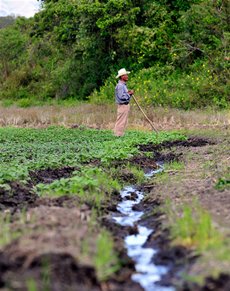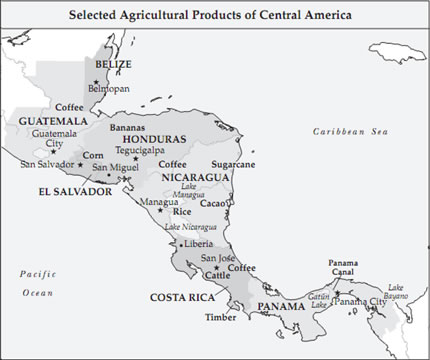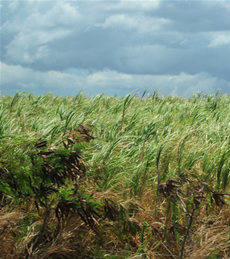Agriculture
Agriculture is generally understood to be concerned with the production of food; however, in Central America, ornamental plants and flowers, forest products, and fibers are also important agricultural commodities.
The nations of Central America are generally considered to be Belize, Costa Rica, El Salvador, Guatemala, Honduras, Nicaragua, and Panama. At the end of the twentieth century, the agricultural sector employed about 46 percent of the available labor force in Central America, most of which was engaged in subsistence agriculture. This percentage is higher than that of the neighboring developing countries of Mexico (28 percent) and Colombia (30 percent).
The Central American percentage is higher than those in more developed countries, such as the United States and Canada, each of which is below 4 percent. The percentage of suitable land in Central America is about equal to that in Mexico (12 percent) but significantly more than in Colombia (4 percent). Arable land in the United States is about 19 percent.
Early Agriculture
Considerable archaeological evidence supports the existence of sedentary agriculture in the region for more than two thousand years. The early Maya farmed raised fields in lowland swamp areas and constructed irrigation systems in areas with a dry season. In highland areas, steep slopes were terraced.
The most prominent terrace agriculture in the Americas was in the Andean cultures, but Central Americans also used this practice. Agriculture was based mainly on corn, but other crops were widely grown, including squash, beans, and chile peppers.Nonfood crops such as cotton and tobacco were grown for both domestic use and trade. These two crops continue to be important.
Exactly what group of Central Americans established the various agricultural practices, or when, is debatable. However, it is known that agriculture supported large communities of people early in the first millennium. The cities of Tikal, Copán, Caracol, and others had populations of thirty-five thousand or more.
Raised field agriculture had several benefits. Sediment dredged from channel bottoms was added to the fields, raising the surface above the surrounding swamp, creating dry land. This material was rich in nutrients from decaying plant matter and wastes from aquatic creatures. Channels of water dividing the dry land provided habitat for fish and turtles, which were a protein-rich food source for people.
Slash-and-burn agriculture was practiced. The process involved stripping forests and burning the debris in place. Trees too large to be cut with primitive stone implements were girded; that is, a circle of bark was removed from around the tree, and the tree died afterward.
Burned debris added nutrients to the topsoil. Because the soil was generally poor, the fields, usually known as milpas, or cornfields, but sometimes referred to as swidden, were abandoned after two or three years of production and left fallow for up to twenty years.This process is still practiced.
Intercropping,or polyculture, was a practice that helped ensure a harvest. The planting of several crops and different varieties provided a harvest even if one crop failed.This practice is also in use today.
Traditional Crops
Since the nineteenth century, certain crops have been raised in Central America as export crops and others principally for domestic consumption. Many of the traditional crops grown are not native to the region.
Many of the most widely grown crops are termed exotics, that is, plants not native to the region that were introduced by European settlers. Bananas, coffee, and sugarcane are three principal exotic crops, with corn being a fourth. Most of the production of introduced plants is grown for export, although native corn is for local use.
Bananas are grown extensively in the Caribbean and Pacific lowlands but most prominently in the Sula Valley of Honduras, a leading world exporter of this crop. The banana industry flourished under the control of North American growers, especially the United Fruit Company. In the later part of the nineteenth century, the banana export business grew and enjoyed large markets in the United States and Europe. The United Fruit Company also exerted strong influence over governmental policies in the region.
Coffee is grown extensively in the highland areas of all seven Central American countries. A slow-ripening crop, coffee requires as much as two months to harvest. Small-scale growers who sell their product through cooperatives produce much of the area?s coffee. The best-quality coffee is shadegrown, and so banana trees often are planted throughout the small fields.
Sugarcane, first introduced by Christopher Columbus to the island of Cuba, is another plant grown throughout a wide area. Sugarcane is labor intensive during harvest but requires little attention at other times. The harvest of sugarcane begins with the burning of the fields.
This practice reduces the volume of foliage and leaves only the stalks, or canes, which are the source of sugar. After the burning?which has the side benefit of chasing out the snakes that inhabit the cane fields?teams of workers with machetes march through the fields cutting the cane.
Corn (maize) is not grown for export. Along with regionally grown rice, it is for domestic consumption. Corn meal is used in the preparation of tortillas, which are eaten at nearly every meal. Rice is commonly served with red or black beans.
Export crops have varied in their economic value to the region. A banana disease nearly ruined the industry in the 1930?s. The Great Depression in those same years sharply reduced exports to North America. Import quotas imposed by the United States on sugar and the U.S. trade embargo on all Cuban products imposed in the early 1960?s provided both a low and a high for Central American sugar producers.
Overproduction of coffee by South American producers has led to depressed prices several times. During the late 1990?s, the European Union?s agricultural import practice of favoring former colonies reduced the value of bananas to growers. In Central America, only Belize (formerly British Honduras) benefits from European tariff regulations.
Nontraditional Crops
Vegetables, high-value crops, and ornamental plants and flowers are being grown at an increased rate. The leading crops are broccoli, cauliflower, snow peas, melons, strawberries, and pineapples. Palm oil from a nonnative tree is another high value farm product.
Nontraditional crops are labor intensive and affect the environment because of the heavy requirements for chemical pesticides. Workers face health risks due to these chemical applications, but employment is high. In Costa Rica, the government encourages investment in reforestation using teak from Southeast Asia.
- African Agriculture
African Agriculture Soil and climatic conditions throughout Africa determine not only agricultural practices, such as which crops can be grown, but also whether plant life is capable of sustaining livestock on the land and enabling fishing of the oceans....
- Australian Agriculture
Australian AgricultureAgriculture is an important part of Australia?s economy. Australia?s exports were overwhelmingly agricultural products until the 1960?s, when mining and manufacturing grew in importance. Agriculture occupies 60 percent of the land...
- Central American Flora
Central American FloraCentral America ? comprising the nations Belize, Costa Rica, El salvador, Guatemala, Honduras, Nicaragua, and Panama ? is a land bridge that connects North America and South America, and many of its plants are similar to plants found...
- European Agriculture
European AgricultureEuropean agricultural practices are affected by the policies of the European Union, in addition to global conditions which influence farming everywhere. Agriculture in Europe goes back to classical times. The development first of the...
- South American Agriculture
South American AgricutureIncreasing urbanization in South America raises questions regarding use of both land that is farmed and land that is abandoned. In South America as elsewhere, landforms, soil, water, climate, and culture interact to produce an...
Agriculture
Central America Agriculture
 |
| Central America Agriculture |
The nations of Central America are generally considered to be Belize, Costa Rica, El Salvador, Guatemala, Honduras, Nicaragua, and Panama. At the end of the twentieth century, the agricultural sector employed about 46 percent of the available labor force in Central America, most of which was engaged in subsistence agriculture. This percentage is higher than that of the neighboring developing countries of Mexico (28 percent) and Colombia (30 percent).
The Central American percentage is higher than those in more developed countries, such as the United States and Canada, each of which is below 4 percent. The percentage of suitable land in Central America is about equal to that in Mexico (12 percent) but significantly more than in Colombia (4 percent). Arable land in the United States is about 19 percent.
Early Agriculture
Considerable archaeological evidence supports the existence of sedentary agriculture in the region for more than two thousand years. The early Maya farmed raised fields in lowland swamp areas and constructed irrigation systems in areas with a dry season. In highland areas, steep slopes were terraced.
The most prominent terrace agriculture in the Americas was in the Andean cultures, but Central Americans also used this practice. Agriculture was based mainly on corn, but other crops were widely grown, including squash, beans, and chile peppers.Nonfood crops such as cotton and tobacco were grown for both domestic use and trade. These two crops continue to be important.
 |
| Early Agriculture |
Exactly what group of Central Americans established the various agricultural practices, or when, is debatable. However, it is known that agriculture supported large communities of people early in the first millennium. The cities of Tikal, Copán, Caracol, and others had populations of thirty-five thousand or more.
Raised field agriculture had several benefits. Sediment dredged from channel bottoms was added to the fields, raising the surface above the surrounding swamp, creating dry land. This material was rich in nutrients from decaying plant matter and wastes from aquatic creatures. Channels of water dividing the dry land provided habitat for fish and turtles, which were a protein-rich food source for people.
Slash-and-burn agriculture was practiced. The process involved stripping forests and burning the debris in place. Trees too large to be cut with primitive stone implements were girded; that is, a circle of bark was removed from around the tree, and the tree died afterward.
Burned debris added nutrients to the topsoil. Because the soil was generally poor, the fields, usually known as milpas, or cornfields, but sometimes referred to as swidden, were abandoned after two or three years of production and left fallow for up to twenty years.This process is still practiced.
Intercropping,or polyculture, was a practice that helped ensure a harvest. The planting of several crops and different varieties provided a harvest even if one crop failed.This practice is also in use today.
Traditional Crops
 |
| Traditional Crops |
Many of the most widely grown crops are termed exotics, that is, plants not native to the region that were introduced by European settlers. Bananas, coffee, and sugarcane are three principal exotic crops, with corn being a fourth. Most of the production of introduced plants is grown for export, although native corn is for local use.
Bananas are grown extensively in the Caribbean and Pacific lowlands but most prominently in the Sula Valley of Honduras, a leading world exporter of this crop. The banana industry flourished under the control of North American growers, especially the United Fruit Company. In the later part of the nineteenth century, the banana export business grew and enjoyed large markets in the United States and Europe. The United Fruit Company also exerted strong influence over governmental policies in the region.
Coffee is grown extensively in the highland areas of all seven Central American countries. A slow-ripening crop, coffee requires as much as two months to harvest. Small-scale growers who sell their product through cooperatives produce much of the area?s coffee. The best-quality coffee is shadegrown, and so banana trees often are planted throughout the small fields.
Sugarcane, first introduced by Christopher Columbus to the island of Cuba, is another plant grown throughout a wide area. Sugarcane is labor intensive during harvest but requires little attention at other times. The harvest of sugarcane begins with the burning of the fields.
This practice reduces the volume of foliage and leaves only the stalks, or canes, which are the source of sugar. After the burning?which has the side benefit of chasing out the snakes that inhabit the cane fields?teams of workers with machetes march through the fields cutting the cane.
Corn (maize) is not grown for export. Along with regionally grown rice, it is for domestic consumption. Corn meal is used in the preparation of tortillas, which are eaten at nearly every meal. Rice is commonly served with red or black beans.
Export crops have varied in their economic value to the region. A banana disease nearly ruined the industry in the 1930?s. The Great Depression in those same years sharply reduced exports to North America. Import quotas imposed by the United States on sugar and the U.S. trade embargo on all Cuban products imposed in the early 1960?s provided both a low and a high for Central American sugar producers.
Overproduction of coffee by South American producers has led to depressed prices several times. During the late 1990?s, the European Union?s agricultural import practice of favoring former colonies reduced the value of bananas to growers. In Central America, only Belize (formerly British Honduras) benefits from European tariff regulations.
Nontraditional Crops
 |
| Nontraditional Crops |
Nontraditional crops are labor intensive and affect the environment because of the heavy requirements for chemical pesticides. Workers face health risks due to these chemical applications, but employment is high. In Costa Rica, the government encourages investment in reforestation using teak from Southeast Asia.
- African Agriculture
African Agriculture Soil and climatic conditions throughout Africa determine not only agricultural practices, such as which crops can be grown, but also whether plant life is capable of sustaining livestock on the land and enabling fishing of the oceans....
- Australian Agriculture
Australian AgricultureAgriculture is an important part of Australia?s economy. Australia?s exports were overwhelmingly agricultural products until the 1960?s, when mining and manufacturing grew in importance. Agriculture occupies 60 percent of the land...
- Central American Flora
Central American FloraCentral America ? comprising the nations Belize, Costa Rica, El salvador, Guatemala, Honduras, Nicaragua, and Panama ? is a land bridge that connects North America and South America, and many of its plants are similar to plants found...
- European Agriculture
European AgricultureEuropean agricultural practices are affected by the policies of the European Union, in addition to global conditions which influence farming everywhere. Agriculture in Europe goes back to classical times. The development first of the...
- South American Agriculture
South American AgricutureIncreasing urbanization in South America raises questions regarding use of both land that is farmed and land that is abandoned. In South America as elsewhere, landforms, soil, water, climate, and culture interact to produce an...
